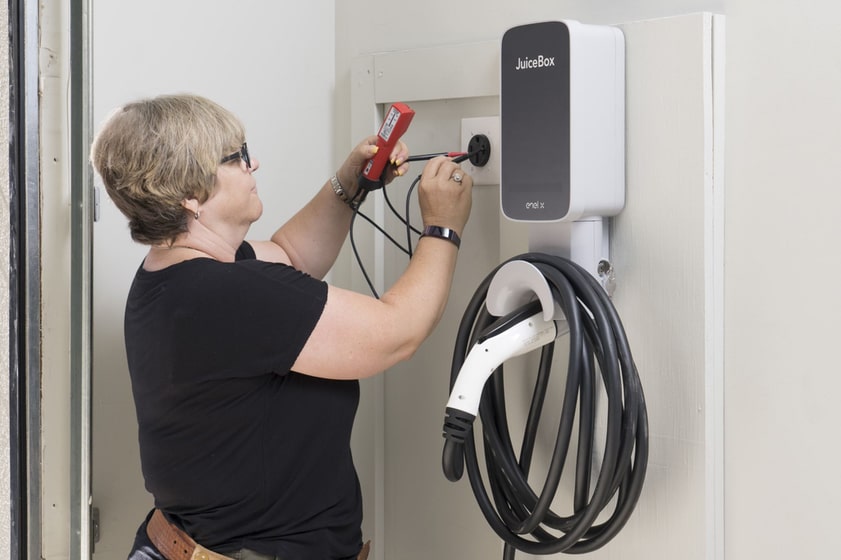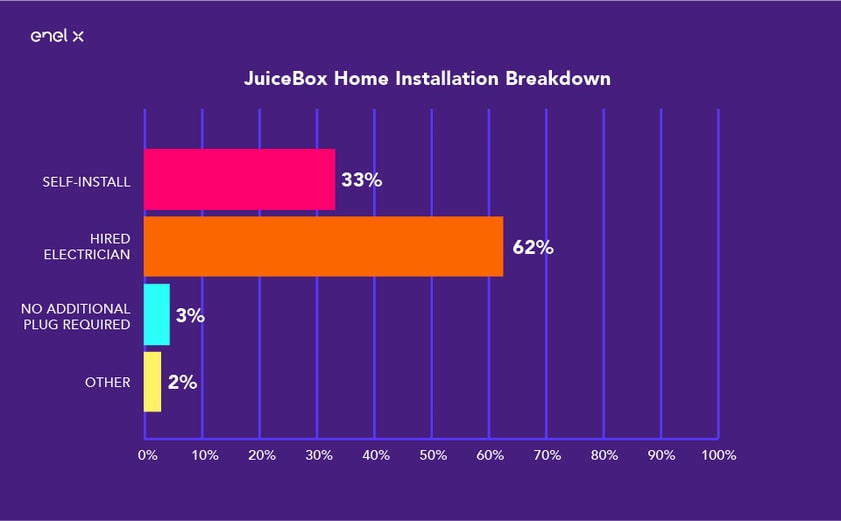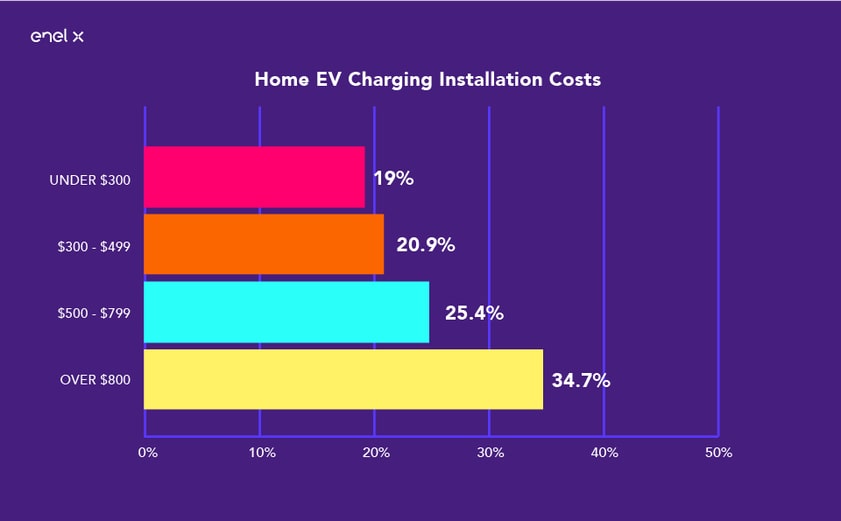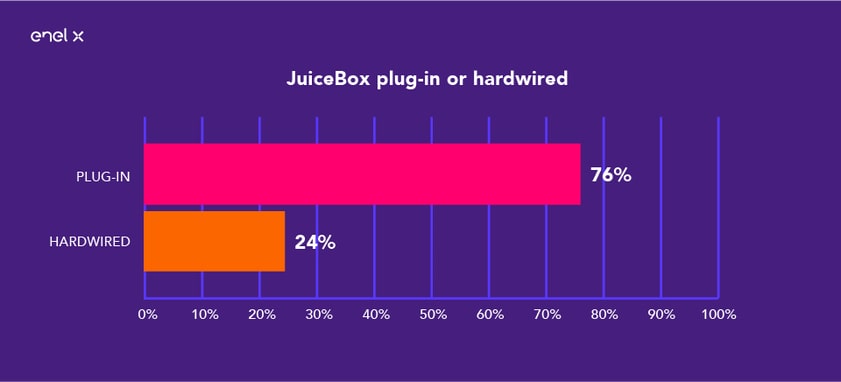How to Install an EV Charger at Home

Imagine never going to a gas station again. That’s the beautiful, everyday reality for EV drivers who quickly and conveniently plug in their cars at home—thereby avoiding the hassle of driving to the pumps. (And the fumes!)
For the best fossil-free driving experience, you’ll want to install a 240-volt electric vehicle home charging station. Unlike the Level 1 charger that usually comes with your electric vehicle, the Level 2 charger can add enough energy for a typical 35-mile commute in less than two hours (compared to about eight hours via a Level 1 charger.) But how do you install a Level 2 home EV charger?
Actually, it’s pretty easy, especially if it’s a plug-in model and you’ve already got the 240-V outlet. Just follow the simple directions provided in the JuiceBox User Manual. Or, hire your local electrician to do it for you – it’s typically a low-cost exercise. So, how to install EV charger at home? Read on for a complete overview of what to expect when installing a home EV charging station.
First Question: Electrician or DIY?
Enel X recently surveyed more than 1,000 JuiceBox customers. One-third of EV owners completed their EV charging station installation on their own, while around two-thirds hired an electrician for the install.

Of those who hired an electrician, around 40% spent less than $500, 65% spent $800 or less, and 34% spent more than $800. Enel X can help you source a qualified local installation partner at the right cost.

Second Question: Hard-Wire or Plug in to an Outlet?
Level 2 home EV chargers —about the size of a shoe box—need to connect to a 240-supply of power in your home. (A separate cord, which leads from the electric vehicle charging station, is the one that connects to the car.) Some municipalities require that the electric vehicle charging station be hardwired to your home’s supply of power. This is more common in the Northeast. A hardwired charging station connection will almost certainly be the case if the charger is exposed to the elements. For that, you’ll need a licensed electrician to wire the device directly to the circuit.
If it’s an option, a simpler route can be to install a heavy-duty outlet —similar to the ones used for a dryer, but with a slightly higher power tolerance so it can support 240 volts. The plug will come with your charging station. Or, you can buy an electric outlet adapter that plugs into a dryer outlet. The charger then simply plugs into the outlet. If you move in the future, the charger can be unplugged and come with you. The most common types of outlets used for EVs are the NEMA 14-50 or NEMA 6-50 plugs. Find out which plug type is right for you.
Our survey results showed that 76% of JuiceBox customers use the plug-in option and 24% use the hardwired option.

Rules of Thumb
Whether or not you use an electrician, and choose hardwiring or a plug-in outlet, there are certain rules of thumb to follow. For starters, your home EV charging station will be connected to your home electrical panel’s circuit breaker that serves the garage or driveway. That supply needs to be on a circuit rated for at least 125% of the device’s continuous load. The math is basic.
• Buy a JuiceBox40, and the circuit should be 50 amps.
(40-amp chargers are good for nearly all EVs.)
• Get a JuiceBox48, and the circuit should be 60-amps.
(48-amp chargers are faster, but only some EVs, those with 11-kW capabilities, can use the extra juice.)
Once you have the necessary amperage, the final consideration is where to position the charging station. Here’s what you need to consider:
• Make sure the charging station is within reach of the vehicle’s charge port.
• Put it at least 18 inches above the floor or ground.
• Ensure the station is within range of your WiFi network or an LTE router (to take advantage of critical smart/connected features).
The Installation
Now that you have the necessary supply of electricity, the correct plug, and have chosen a strategic spot for your charging station, it’s time to install that puppy. Safety first! Turn off the circuit breaker to the outlet or hardwired charging station electrical connection.
The JuiceBox level 2 charging station weighs between 15 and 17 pounds depending on the model. The dimensions are 7.6” x 18.6” x 5.6”. The input cable is two feet long, so the JuiceBox should be mounted close to the outlet. Use a stud sensor to determine an appropriate mounting location, then use the two screws to secure the wall bracket. Tighten the screws as noted in the instructions, and attach the JuiceBox using the easy mounting bracket.
Plug in the charging station, turn the circuit breaker back on and confirm that it’s receiving juice. If the green bar on the front of the JuiceBox lights up, then you’re in business. Wind the charging station’s charging cable (the one leading to the hand-held connector that gets plugged into the car) around the holder. You’re almost ready for your first home charging session.
Smart Charging
There’s one last step, and it’s an important one. With a smart charger like the JuiceBox home EV charger, you’ll be able to schedule EV charging to take place automatically during less expensive, off-peak times. Utilities offer attractive EV Time-of-Use rates to ensure that EV drivers maximize the use of renewable energy, which is more abundant during certain times of the day.
That requires connecting the JuiceBox to WiFi to leverage the JuiceNet IoT platform. The mobile app makes this a piece of cake. Open WiFi settings on your smartphone while standing close to the JuiceBox. Go to the setup functions, select the WiFi network and enter the WiFi password. Click Connect, and you’re done.
That’s it. Steer your EV next to the charging station and plug in. Sit back as electricity flows into the batteries. EV charging stations don’t require maintenance. After it’s set up once, charging your EV will be a breeze.


